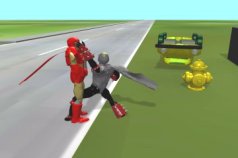(Lucas Kovar and Michael Gleicher; SIGGRAPH '04)
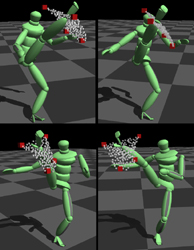
PDF
Large motion data sets often contain many variants of the same
kind of motion, but without appropriate tools it is difficult to
fully exploit this fact. This paper provides automated methods
for identifying logically similar motions in a data set and using
them to build a continuous and intuitively parameterized space of
motions. To find logically similar motions that are numerically
dissimilar, our search method employs a novel distance metric to
find ``close'' motions and then uses them as intermediaries to
find more distant motions. Search queries are answered at
interactive speeds through a precomputation that compactly
represents all possibly similar motion segments. Once a set of
related motions has been extracted, we automatically register them
and apply blending techniques to create a continuous space of
motions. Given a function that defines relevant motion
parameters, we present a method for extracting motions from this
space that accurately possess new parameters requested by the
user. Our algorithm extends previous work by explicitly
constraining blend weights to reasonable values and having a
run-time cost that is nearly independent of the number of example
motions. We present experimental results on a test data set of
37,000 frames, or about ten minutes of motion sampled at 60
Hz.
(Hyun Joon Shin, Lucas Kovar, and Michael Gleicher; Pacific Graphics '03)
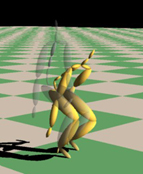
PDF
Most popular motion editing methods do not take physical principles into account, potentially producing physically implausible motions. We present a method for "touching up" motions to improve physical plausibility. Specifically, we first divide the motion into ground and flight stages and then enforce zero moment point constraints in the former and linear/angular momentum constraints in the latter. Unlike previous methods, we do not employ nonlinear optimization; rather, we use efficient closed form algorithms that allow a user to build a set of hierarchical displacement maps which refine user-specified degrees of freedom at different scales.
(Lucas Kovar and Michael Gleicher; SCA '03)
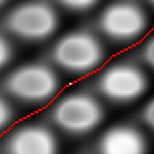
PDF
Many motion editing algorithms, including transitioning and
multitarget interpolation, can be represented as instances of a
more general operation called motion blending. We introduce a
novel data structure called a registration curve that
expands the class of motions that can be successfully blended
without manual input. Registration curves achieve this by
automatically determining relationships involving the timing,
local coordinate frame, and constraints of the input motions. We
show how registration curves improve upon existing automatic
blending methods and demonstrate their use in common blending
operations.
(Michael Gleicher, Hyun Joon Shin, Lucas Kovar, and Andrew Jepsen; I3D '03)
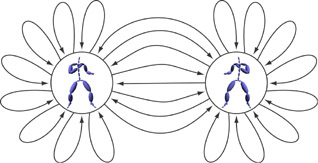
PDF
Many virtual environments and games must be populated with
synthetic characters to create the desired experience. These
characters must move with sufficient realism, so as not to destroy
the visual quality of the experience, yet be responsive,
controllable, and efficient to simulate. In this paper we present
an approach to character motion called Snap-Together Motion
that addresses the unique demands of virtual environments.
Snap-Together Motion preprocesses a corpus of motion capture
examples into a set of short clips that can be concatenated to
make continuous streams of motion. The result is a simple
graph structure that facilitates efficient planning of character
motions. A user-guided process selects ``common'' character poses
and the system automatically synthesizes multi-way transitions
that connect through these poses. In this manner well-connected
graphs can be constructed to suit a particular application,
allowing for practical interactive control without the effort of
manually specifying all transitions.
(Lucas Kovar, Michael Gleicher, and Fred Pighin; SIGGRAPH '02)
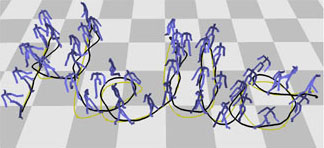
PDF
This work presents a novel method for creating realistic, controllable
motion. Given a corpus of motion capture data, we automatically
construct a directed graph called a motion graph that
encapsulates connections among the motions in a database. The motion graph consists both of pieces of original motion and automatically generated transitions. Motion can be generated simply by building walks on the graph. We present a general framework for extracting particular graph walks that meet a user's specifications. We then show how this framework can be applied to the specific problem of generating
different styles of locomotion along arbitrary paths.
(Lucas Kovar, John Schreiner, and Michael Gleicher; SCA '02)
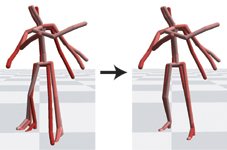
PDF
While motion capture is commonplace in character animation, often the
raw motion data itself is not used. Rather, it is first fit onto a
skeleton and then edited to satisfy the particular demands of the
animation. This process can introduce artifacts into the motion. One
particularly distracting artifact is when the character's feet move
when they ought to remain planted, a condition known as footskate. In
this work we present a simple, efficient algorithm for removing
footskate. Our algorithm exactly satisfies footplant constraints
without introducing disagreeable artifacts.
(Lucas Kovar and Michael Gleicher; UIST '02)
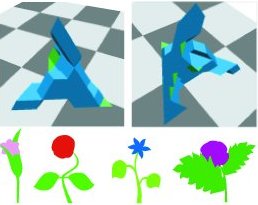
PDF
This work presents a method for helping artists make artwork
more accessible to casual users. We focus on the specific case of
drawings, showing how a small number of drawings can be transformed
into a richer object containing an entire family of similar drawings.
This object is represented as a simplicial complex approximating a set
of valid interpolations in configuration space. The artist does not
interact directly with the simplicial complex. Instead, she guides
its construction by answering a specially chosen set of yes/no
questions. By combining the topological generality of a simplicial
complex with direct human guidance, we are able to represent very
general constraints on membership in a family. The constructed
simplicial complex supports a variety of algorithms useful to an end
user, including random sampling of the space of drawings, constrained
interpolation between drawings, projection of another drawing into the
family, and interactive exploration of the family.
|
